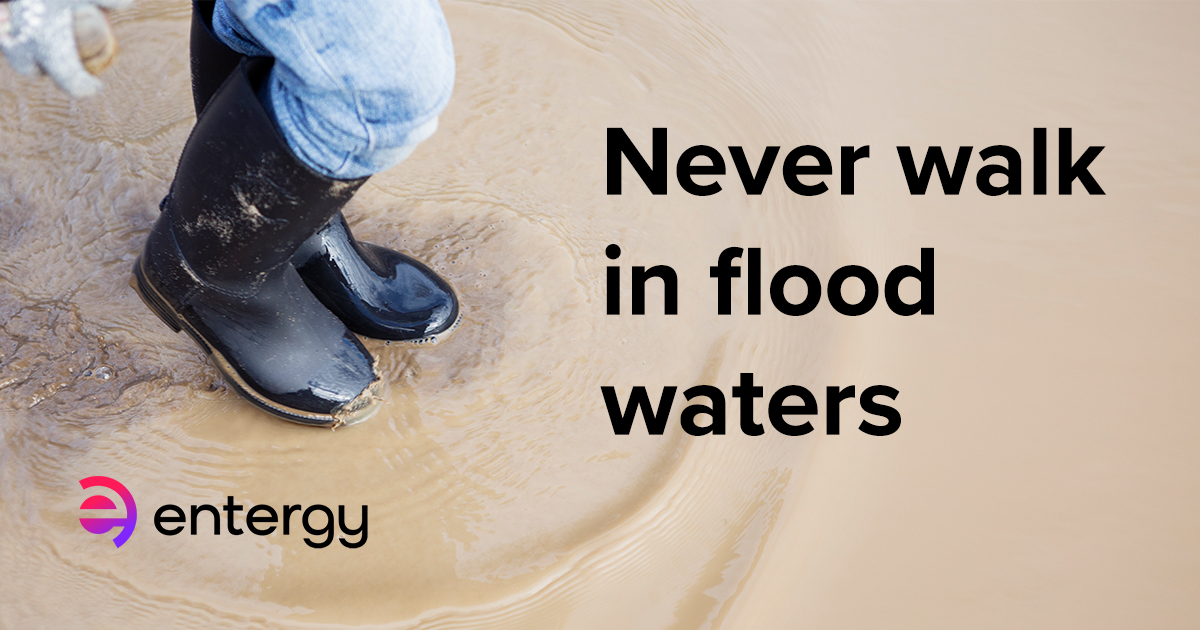
Water and electricity can be a fatal combination
Stay away from and don’t walk in flooded areas or standing water. Remember that wet tree limbs can conduct electricity, too.
Flooding is the most common natural disaster in the United States, and it strikes our service area frequently. We work closely with local emergency officials and civil defense departments to monitor the latest information on flood stages and ensure the safety of our employees and the public.
Flood facts
Flooding can occur during any season and in any U.S. state or territory. It’s particularly important to be prepared for flooding if you live in a low-lying area near a body of water, such as a river, stream or culvert; along a coast; or downstream from a dam or levee.
Flooding can occur slowly, as rain continues to fall for many days, or it can happen very quickly. Flash floods develop with little or no warning. Strong winds from a tropical cyclone or hurricane can also create storm surges in coastal regions.
In some cases, rising water levels in our service territory will require us to disconnect electrical service in certain areas as a public safety precaution. Service also must be disconnected any time water enters a dwelling or when water levels approach a structure’s electrical system. In such cases, we’ll provide regular updates to our customers through the many available communication channels. Learn how you can stay in touch with us.
Flooding can occur slowly, as rain continues to fall for many days, or it can happen very quickly.
Preparing for flooding
- Have a family emergency plan and a kit of basic supplies. It’s one of the best ways to be prepared for any type of severe weather.
- Know your flood risk. Find out if you live, work or travel through areas prone to flooding. Based on what you learn, familiarize yourself with evacuation routes and assess the need for flood insurance.
- If you own a generator, review the instructions. Be prepared to operate it according to the manufacturer’s guidelines. Learn more about generator safety.
- Particularly if you are considering evacuation, remove all food from freezers and refrigerators. Bring in outdoor furniture, and move important items to a higher elevation if possible. Shut off the electricity by locating your electrical circuit box. For your safety, always shut off all the individual circuits before shutting off the main circuit.

Flood safety
- Stay away from downed lines. If you see a downed line, keep your distance and call 1-800-9OUTAGE to report it.
- Avoid areas of debris, as downed and energized power lines may not be visible.
- Don’t walk or drive through flood waters. Just six inches of moving water can knock you down, and one foot of water can sweep your vehicle away. In addition, water may be electrified from nearby downed lines.
- Use extreme caution when navigating boats in flooded areas around power lines to ensure boats and their occupants don’t come into contact with energized lines.
When you return home
- Return home only when authorities say it’s safe.
- Drive only on roads the authorities have declared passable. Water is powerful. Roads and bridges may have been weakened or washed out during the flood.
- Remember, your house may have serious damage. Only enter if safe to do so.
- If your home flooded during the storm, you may need to take special actions before electric service can be restored. Learn more in this quick video.
- Use a flashlight to check for damage around your home. Never use candles, matches or other open flame.
- Check to see that the electric, gas and water services are not damaged. Have licensed professionals check gas, water and electrical lines and appliances for damage. If you find or suspect damaged gas or power lines, call us at 1-800-9OUTAGE to report them.
- Use tap water for drinking and cooking only when local officials say it is safe to do so.
For more information, consult the Federal Emergency Management Agency's Preparing for a flood.
Terms to know
Flood Watch: Watches inform of possible flooding. If you are in a watch area, check flood action plans, keep informed and be ready to act if a warning is issued or you see flooding.
Flood or Flash Flood Warning: A flood/flash flood warning is issued for specific communities, streams or areas where flooding is imminent or in progress. Persons in the warning area should take precautions immediately. Be prepared to move to higher ground on short notice.
Sources: FEMA, U.S. Department of Homeland Security.
Call 1-800-9OUTAGE (1-800-968-8243) to report downed power lines
